By John Treadwell Dunbar ——Bio and Archives--August 2, 2010
Travel | CFP Comments | Reader Friendly | Subscribe | Email Us
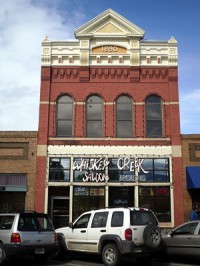 Like so many writers, artists, actors and a steady stream of celebrities drawn to Montana’s splendor where landscape is muse, the late, great motion picture director “Bloody Sam” Peckinpah likewise succumbed to the lure. Known for such iconic Western masterpieces as “Ride the High Country” (1962) and “The Wild Bunch,” (1969) Peckinpah settled in Livingston, sixty miles north of Yellowstone National Park, where he lived out the remainder of his complex and contentious life.
From 1978 to 1985 when he died of heart failure, Peck called an expansive upstairs suite at the four-story Murray Hotel home. Whether he came for inspiration or respite, judging by the epics he assembled during his fabled career and his wild, drug and alcohol-fueled life, Sam Peckinpah belonged in Livingston; he has become part of the rough-edged, Western fabric that shapes the region’s lore to this day.
Like so many writers, artists, actors and a steady stream of celebrities drawn to Montana’s splendor where landscape is muse, the late, great motion picture director “Bloody Sam” Peckinpah likewise succumbed to the lure. Known for such iconic Western masterpieces as “Ride the High Country” (1962) and “The Wild Bunch,” (1969) Peckinpah settled in Livingston, sixty miles north of Yellowstone National Park, where he lived out the remainder of his complex and contentious life.
From 1978 to 1985 when he died of heart failure, Peck called an expansive upstairs suite at the four-story Murray Hotel home. Whether he came for inspiration or respite, judging by the epics he assembled during his fabled career and his wild, drug and alcohol-fueled life, Sam Peckinpah belonged in Livingston; he has become part of the rough-edged, Western fabric that shapes the region’s lore to this day.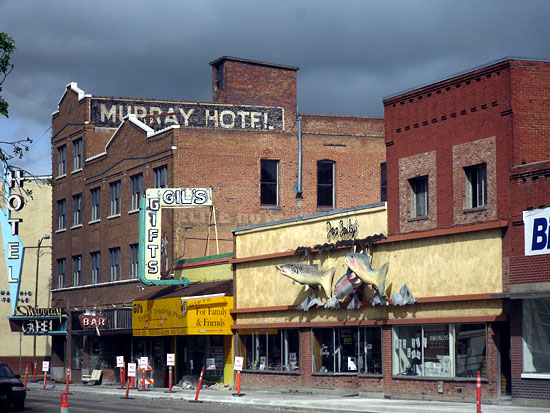 In some ways Peckinpah epitomized in a late-twentieth-century fashion that colorful cast of reckless characters that traipsed through this special corner of Montana over the last two centuries; cowboys and cowgirls and ranchers, mountain men and gold seekers, tycoons and tramps and a predictable rabble of lawless miscreants; many an outcast dwelling out there on the margins. They arrived seduced by the prospects of fortune and a better life in this splendid little railroad town of rich Western tradition with its 430 historic architectural beauties, near the banks of cottonwood-shrouded Yellowstone River, at the foot of the mighty Absaroka Mountains, on the edge of never-ending prairie, under a very big and deep-blue Montana sky.
One of the earliest Anglo-Americans to set eyes on the Yellowstone River valley was Captain William Clark of Lewis and Clark fame who passed through in July of 1806 on his return trip from the Pacific Ocean. Accompanied by Shoshone Indian guide Sacajawea, Clark apparently rested for a couple of hours within the future town proper, commented in his journal on the abundance of mosquitoes and that evening set up camp a few miles east of Livingston just past the Shields River.
Famed trapper and mountain man Jim Bridger is claimed to have wintered in 1844 down in secluded Paradise Valley which lies between Livingston and Yellowstone National Park. Accompanied by Crow Indians, they left a large pile of deer, antelope, elk and buffalo skulls as a monument to their sojourn. In years that followed, large ranches took hold in Paradise Valley by such notables as Nelson Story who, allegedly, became the inspiration for Larry McMurtry’s Pulitzer Prize-winning epic, and subsequent movie, “Lonesome Dove.”
In some ways Peckinpah epitomized in a late-twentieth-century fashion that colorful cast of reckless characters that traipsed through this special corner of Montana over the last two centuries; cowboys and cowgirls and ranchers, mountain men and gold seekers, tycoons and tramps and a predictable rabble of lawless miscreants; many an outcast dwelling out there on the margins. They arrived seduced by the prospects of fortune and a better life in this splendid little railroad town of rich Western tradition with its 430 historic architectural beauties, near the banks of cottonwood-shrouded Yellowstone River, at the foot of the mighty Absaroka Mountains, on the edge of never-ending prairie, under a very big and deep-blue Montana sky.
One of the earliest Anglo-Americans to set eyes on the Yellowstone River valley was Captain William Clark of Lewis and Clark fame who passed through in July of 1806 on his return trip from the Pacific Ocean. Accompanied by Shoshone Indian guide Sacajawea, Clark apparently rested for a couple of hours within the future town proper, commented in his journal on the abundance of mosquitoes and that evening set up camp a few miles east of Livingston just past the Shields River.
Famed trapper and mountain man Jim Bridger is claimed to have wintered in 1844 down in secluded Paradise Valley which lies between Livingston and Yellowstone National Park. Accompanied by Crow Indians, they left a large pile of deer, antelope, elk and buffalo skulls as a monument to their sojourn. In years that followed, large ranches took hold in Paradise Valley by such notables as Nelson Story who, allegedly, became the inspiration for Larry McMurtry’s Pulitzer Prize-winning epic, and subsequent movie, “Lonesome Dove.”

 Of all the characters that called Livingston home on occasion, none captures the imagination more than Martha Cannary, better known as Calamity Jane. From the looks of her photographs, Calamity might have been a fox in her younger years, but she was no Doris Day as time went by. Six-foot-tall with a scowl that testified to a hard life of hard liquor and overexposure to the elements and a man’s life, colorful Calamity spent considerable time in and around Livingston. She supposedly lived in a cabin on the 200 block of South Main Street, and was smart, kind, generous to the needy and could be a crank when it suited her, like the rest of us.
By all accounts she was accomplished, wrote her own biography, was a superb marksman and made ends meet by scouting, running a restaurant, killing an occasional Indian, and brokering the sale of Paradise Valley cattle. Not to be outdone by her male counterparts, she gained fame as an expert bullwhacker and whacked bulls with the best of them, cracking a twenty-foot leather whip over the backs of twenty oxen that hauled as many as three enormous freight wagons to such far reaches as Cooke City northeast of Yellowstone Park.
Of all the characters that called Livingston home on occasion, none captures the imagination more than Martha Cannary, better known as Calamity Jane. From the looks of her photographs, Calamity might have been a fox in her younger years, but she was no Doris Day as time went by. Six-foot-tall with a scowl that testified to a hard life of hard liquor and overexposure to the elements and a man’s life, colorful Calamity spent considerable time in and around Livingston. She supposedly lived in a cabin on the 200 block of South Main Street, and was smart, kind, generous to the needy and could be a crank when it suited her, like the rest of us.
By all accounts she was accomplished, wrote her own biography, was a superb marksman and made ends meet by scouting, running a restaurant, killing an occasional Indian, and brokering the sale of Paradise Valley cattle. Not to be outdone by her male counterparts, she gained fame as an expert bullwhacker and whacked bulls with the best of them, cracking a twenty-foot leather whip over the backs of twenty oxen that hauled as many as three enormous freight wagons to such far reaches as Cooke City northeast of Yellowstone Park.
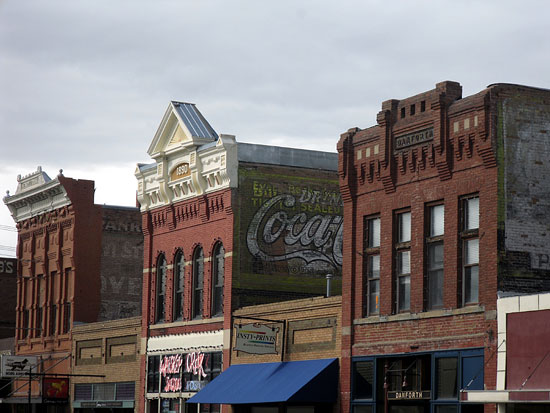 Two major events placed Livingston firmly on the map in the 1800s. The first was Northern Pacific Railroad’s strategic decision to locate its locomotive repair shops here. The shops grew to become the largest such facility between Seattle and Saint Paul. At one point the railroad industry employed 2,200 in Livingston, and it was primarily due to the influx of materials and burgeoning opportunity that the impressive buildings one finds in Livingston today came into existence.
The second event was the creation of Yellowstone National Park and the arrival of tens of thousands of tourists to this northern gateway. Hard to imagine, but once Northern Pacific completed its spur line south to the small town of Gardiner near the park’s boundary, as many as 30,000 Yellowstone visitors were known to travel on upwards of six trains daily in subsequent years, according to the brochure. The age of industrial tourism had begun.
Between the railroad’s arrival and Yellowstone’s protection, commercial growth of the downtown area was inevitable and astounding beginning in 1882. Within twenty-seven years, banks, factories, merchant blocks and lumberyards exploded on the scene in a frenzy. To accommodate new arrivals moving into the area, and the endless parade of tourists domestic and foreign, 13 hotels were built between 1883 and 1914 which lodged dignitaries and politicians from the New as well as the Old World.
Two major events placed Livingston firmly on the map in the 1800s. The first was Northern Pacific Railroad’s strategic decision to locate its locomotive repair shops here. The shops grew to become the largest such facility between Seattle and Saint Paul. At one point the railroad industry employed 2,200 in Livingston, and it was primarily due to the influx of materials and burgeoning opportunity that the impressive buildings one finds in Livingston today came into existence.
The second event was the creation of Yellowstone National Park and the arrival of tens of thousands of tourists to this northern gateway. Hard to imagine, but once Northern Pacific completed its spur line south to the small town of Gardiner near the park’s boundary, as many as 30,000 Yellowstone visitors were known to travel on upwards of six trains daily in subsequent years, according to the brochure. The age of industrial tourism had begun.
Between the railroad’s arrival and Yellowstone’s protection, commercial growth of the downtown area was inevitable and astounding beginning in 1882. Within twenty-seven years, banks, factories, merchant blocks and lumberyards exploded on the scene in a frenzy. To accommodate new arrivals moving into the area, and the endless parade of tourists domestic and foreign, 13 hotels were built between 1883 and 1914 which lodged dignitaries and politicians from the New as well as the Old World.
 Of the wonderful architectural relics that remain, the Northern Pacific Depot, now a museum, is regarded as the town’s centerpiece. Constructed in 1902 and designed by the original architects of Grand Central Station, the sprawling depot has a decidedly Italian style, beautiful but uncharacteristic in light of the weathered brick that dominates elsewhere.
Other noteworthy buildings can be found if you pick up a walking-tour map at the local visitors center. Look for the Redeemer Lutheran Church on West Lewis. It was used in the critically-acclaimed Robert Redford-directed film “A River Runs Through It.” The affluent carved out their neighborhood over in the west side historic district where large stately residential homes continue to serve their purpose. Reflecting the style of the times, you’ll find Victorian porches, square towers capped with flared hip roofs, Omaha pressed brick, porticoed entrances, Ionic columns, sand beige brick homes and large octagonal corner towers.
Livingston had dopers, too, opium-smoking Chinese who kicked back in their smoky opium dens and were part of the under-appreciated, hard-working Chinese community segregated in Chinatown. Many were forced to live underground on the northeast side of the city like rats and scurry back and forth through underground tunnels until they were unceremoniously run off.
For those with the urge, Livingston also had its share of “soiled doves,” or “ladies of the night.” They were permitted to ply their recession-proof trade between Lewis and Clark streets in four nondescript, one-story buildings that still stand, although I believe they’ve been out of business for quite some time, so don’t go knocking.
My favorite structures are the old merchant buildings lining the east side of North Main Street, many of which were built in the 1880s. For whatever reason, they alternate between one- and two-stories tall, an unusual symmetry that reveals faded advertising for Coca Cola and cigar ads on the sides of the upper-level walls; a distinctive complement to 20 facades restored to their original condition, and decorative cornices and fanciful brickwork that adorn these historically rich city blocks.
Of the wonderful architectural relics that remain, the Northern Pacific Depot, now a museum, is regarded as the town’s centerpiece. Constructed in 1902 and designed by the original architects of Grand Central Station, the sprawling depot has a decidedly Italian style, beautiful but uncharacteristic in light of the weathered brick that dominates elsewhere.
Other noteworthy buildings can be found if you pick up a walking-tour map at the local visitors center. Look for the Redeemer Lutheran Church on West Lewis. It was used in the critically-acclaimed Robert Redford-directed film “A River Runs Through It.” The affluent carved out their neighborhood over in the west side historic district where large stately residential homes continue to serve their purpose. Reflecting the style of the times, you’ll find Victorian porches, square towers capped with flared hip roofs, Omaha pressed brick, porticoed entrances, Ionic columns, sand beige brick homes and large octagonal corner towers.
Livingston had dopers, too, opium-smoking Chinese who kicked back in their smoky opium dens and were part of the under-appreciated, hard-working Chinese community segregated in Chinatown. Many were forced to live underground on the northeast side of the city like rats and scurry back and forth through underground tunnels until they were unceremoniously run off.
For those with the urge, Livingston also had its share of “soiled doves,” or “ladies of the night.” They were permitted to ply their recession-proof trade between Lewis and Clark streets in four nondescript, one-story buildings that still stand, although I believe they’ve been out of business for quite some time, so don’t go knocking.
My favorite structures are the old merchant buildings lining the east side of North Main Street, many of which were built in the 1880s. For whatever reason, they alternate between one- and two-stories tall, an unusual symmetry that reveals faded advertising for Coca Cola and cigar ads on the sides of the upper-level walls; a distinctive complement to 20 facades restored to their original condition, and decorative cornices and fanciful brickwork that adorn these historically rich city blocks.
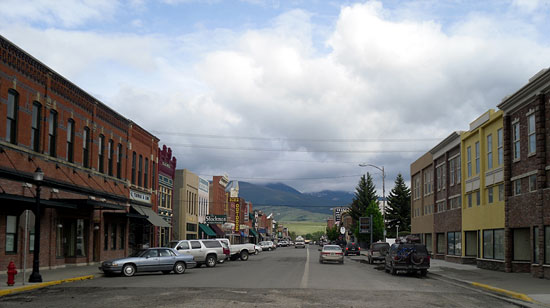 Today Livingston continues to serve as a gateway to Yellowstone National Park. Due to the influx of the world’s tourists, and Montana State University thirty miles west in Bozeman, this town has never been as provincial as many conservative Montana cities. You still have your cowboys and ranchers, the shucks and by-golly crowd, but they might be wearing ball caps, not Stetsons, haven’t ridden a horse in years, are toting BlackBerries and might have earned an undergraduate degree or two. In fact, Livingston and the Paradise Valley, a colony of artists and writers and the A-list film crowd, seems to be rather cosmopolitan, but under the radar and with a bluish political tint compared to the rest of eastern Montana.
With a population of around 7,000, there is plenty to do. Livingston promotes itself as “The Heart of Art in Montana.” Maybe, considering the number of fine art galleries and the ever-popular summer Art Walks. Festivals are popular, like the three-day Summerfest held down at the park near the river in July. They celebrate with live music, arts and crafts displays and great food and drink. The annual Fiddlers Picnic draws musicians and spectators by the hundreds to enjoy a wide range of bluegrass, and if you can stomach it, country and western music. Livingston also boasts two community theaters performing an array of dramas, musicals and comedies. There’s also the Yellowstone Gateway Museum. And remember, church on Sunday.
Today Livingston continues to serve as a gateway to Yellowstone National Park. Due to the influx of the world’s tourists, and Montana State University thirty miles west in Bozeman, this town has never been as provincial as many conservative Montana cities. You still have your cowboys and ranchers, the shucks and by-golly crowd, but they might be wearing ball caps, not Stetsons, haven’t ridden a horse in years, are toting BlackBerries and might have earned an undergraduate degree or two. In fact, Livingston and the Paradise Valley, a colony of artists and writers and the A-list film crowd, seems to be rather cosmopolitan, but under the radar and with a bluish political tint compared to the rest of eastern Montana.
With a population of around 7,000, there is plenty to do. Livingston promotes itself as “The Heart of Art in Montana.” Maybe, considering the number of fine art galleries and the ever-popular summer Art Walks. Festivals are popular, like the three-day Summerfest held down at the park near the river in July. They celebrate with live music, arts and crafts displays and great food and drink. The annual Fiddlers Picnic draws musicians and spectators by the hundreds to enjoy a wide range of bluegrass, and if you can stomach it, country and western music. Livingston also boasts two community theaters performing an array of dramas, musicals and comedies. There’s also the Yellowstone Gateway Museum. And remember, church on Sunday.
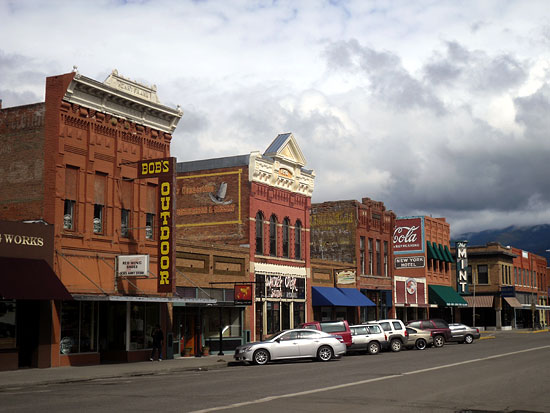 For those travelers wanting a taste of Wild West entertainment, make sure you attend a rodeo. With annual summer events in Livingston, Wilsall and Gardiner, the spectacle is well worth the price of admission, especially if you love horses and all things related. Though I’ve never attended any of these particular rodeos, I have others and similar threads run through them from the obligatory parade to the tight jeans and pointy boots, the flowered shirts and those ten-gallon hats, and all of that masticated chew and the blurry-eyed, redneck addicts with the rotting teeth hooked on crystal meth who think they’ve got us fooled.
It’s rousing fun, all of it good; the boisterous bleacher crowds and flags snapping in the wind and wild applause and the drone of the loudspeaker, the nearness of those aromatic horses trotting and snorting and leather saddles squeaking and pretty cowgirls bouncing up and down in their pretty flowered shirts, and bouncing and bouncing, and the sight of cantankerous 2,000-pound rough stock waiting their turn behind stout corrals, and the earthy, significant odors that cling to your clothes and clog your nostrils, and those cute little calves that are run down by men on horse and roped around the neck, choked and snapped back and hoisted up and thrown to the ground with a bone-crushing thud by muscle-bound, corn-fed ranchers who buck hay in their spare time; and those barrel-racing females leaning over the long necks of their quick and nimble quarter horses, heels kicking and thrashing and manes flowing as they gallop and spin turns around the barrel and gallop and turn and gallop and turn and gallop home just like that; and those bucking broncos chucking up and down, hopping and kicking as their wide-eyed riders cling for dear life, legs snapping out and back in rhythm as spurs dig and claw, and then the release and the long skyward arc as Cowboy Bob sails through the air and lands with a resounding thud on a pile of, you know, and all of that is great rodeo stuff, but truth be told, the main draw always has been and always will be the wild bull riding, until the animal rights activists shut that down as well.
For those travelers wanting a taste of Wild West entertainment, make sure you attend a rodeo. With annual summer events in Livingston, Wilsall and Gardiner, the spectacle is well worth the price of admission, especially if you love horses and all things related. Though I’ve never attended any of these particular rodeos, I have others and similar threads run through them from the obligatory parade to the tight jeans and pointy boots, the flowered shirts and those ten-gallon hats, and all of that masticated chew and the blurry-eyed, redneck addicts with the rotting teeth hooked on crystal meth who think they’ve got us fooled.
It’s rousing fun, all of it good; the boisterous bleacher crowds and flags snapping in the wind and wild applause and the drone of the loudspeaker, the nearness of those aromatic horses trotting and snorting and leather saddles squeaking and pretty cowgirls bouncing up and down in their pretty flowered shirts, and bouncing and bouncing, and the sight of cantankerous 2,000-pound rough stock waiting their turn behind stout corrals, and the earthy, significant odors that cling to your clothes and clog your nostrils, and those cute little calves that are run down by men on horse and roped around the neck, choked and snapped back and hoisted up and thrown to the ground with a bone-crushing thud by muscle-bound, corn-fed ranchers who buck hay in their spare time; and those barrel-racing females leaning over the long necks of their quick and nimble quarter horses, heels kicking and thrashing and manes flowing as they gallop and spin turns around the barrel and gallop and turn and gallop and turn and gallop home just like that; and those bucking broncos chucking up and down, hopping and kicking as their wide-eyed riders cling for dear life, legs snapping out and back in rhythm as spurs dig and claw, and then the release and the long skyward arc as Cowboy Bob sails through the air and lands with a resounding thud on a pile of, you know, and all of that is great rodeo stuff, but truth be told, the main draw always has been and always will be the wild bull riding, until the animal rights activists shut that down as well.
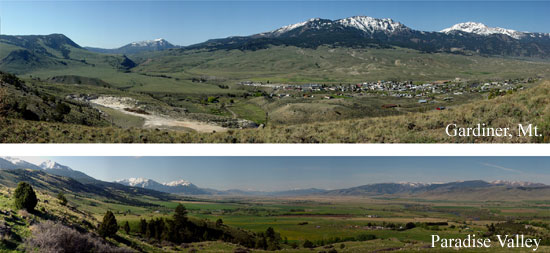 And it’s not just the bull riding that’s the draw, but the wreck that typically follows. Who doesn’t love the thrill and excitement of watching mean-ugly, big-humped, rough-stock riding bulls try and dislodge their riders who are advancing their bumpy careers eight seconds at a time, and who’ve had common sense knocked out of them long ago. Oh my, these guys are tough and put NFL linemen, all of them, to shame. I gave up long ago trying to figure out why these knuckleheads don’t want kids, but whatever the reason, it’s quite the show.
Twisting, kicking, rolling, turning, flailing, flopping, snapping, grunting, bumping and grinding and spinning uncontrollably, or so it seems, as 2,000 pounds of angry tries to fling the uninvited guest through the air. This is the real deal, and that bull has only three thoughts on his simple mind; throw the rider, kill him, and then get rid of that pesky flank strap. Hats off to all bull riders, true athletes each and every one. It’s enough to make you stand at attention and salute as they lift themselves off the dirt, slap their dusty hats against their leather chaps, wave to the appreciative crowd and saunter bowlegged back to the bar.
Clippings
And it’s not just the bull riding that’s the draw, but the wreck that typically follows. Who doesn’t love the thrill and excitement of watching mean-ugly, big-humped, rough-stock riding bulls try and dislodge their riders who are advancing their bumpy careers eight seconds at a time, and who’ve had common sense knocked out of them long ago. Oh my, these guys are tough and put NFL linemen, all of them, to shame. I gave up long ago trying to figure out why these knuckleheads don’t want kids, but whatever the reason, it’s quite the show.
Twisting, kicking, rolling, turning, flailing, flopping, snapping, grunting, bumping and grinding and spinning uncontrollably, or so it seems, as 2,000 pounds of angry tries to fling the uninvited guest through the air. This is the real deal, and that bull has only three thoughts on his simple mind; throw the rider, kill him, and then get rid of that pesky flank strap. Hats off to all bull riders, true athletes each and every one. It’s enough to make you stand at attention and salute as they lift themselves off the dirt, slap their dusty hats against their leather chaps, wave to the appreciative crowd and saunter bowlegged back to the bar.
Clippings
View Comments
John Treadwell Dunbar is a freelance writer